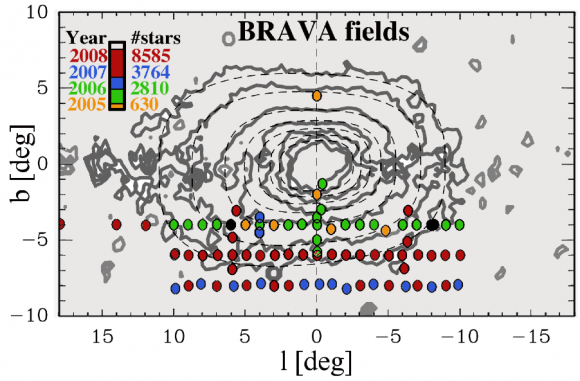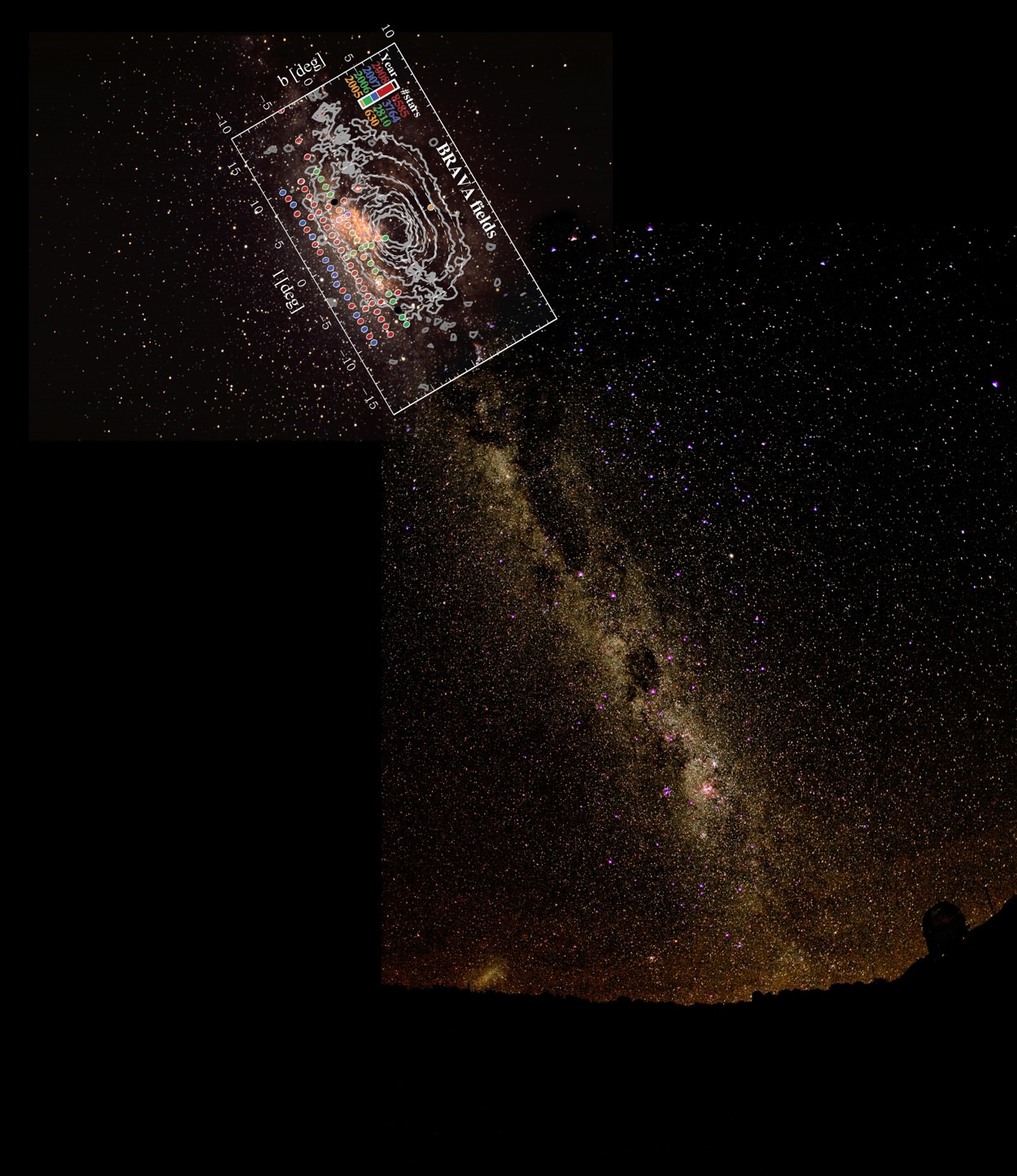[/caption]You may have heard about the restaurant at the end of the Universe, but have you heard of the bar in the middle of the Milky Way?
Nearly 80 years ago, astronomers determined that our home, the Milky Way Galaxy, is a large spiral galaxy. Despite being stuck inside and not being able to see what the entire the structure looks like — as we can with the Pinwheel Galaxy, or our nearest neighbor, the Andromeda Galaxy — researchers have suspected our galaxy is actually a “barred” spiral galaxy. Barred spiral galaxies feature an elongated stellar structure , or bar, in the middle which in our case is hidden by dust and gas. There are many galaxies in the Universe that are barred spirals, and yet, there are numerous galaxies which do not feature a central bar.
How do these central bars form, and why are they only present in some, but not all spiral galaxies?
A research team led by Dr. R. Michael Rich (UCLA), dubbed BRAVA (Bulge Radial Velocity Assay), measured the velocity of many old, red stars near the center of our galaxy. By studying the spectra (combined light) of the M class giant stars, the team was able to calculate the velocity of each star along our line of sight. During a four-year time span, the spectra for nearly 10,000 stars was acquired with the CTIO Blanco 4-meter telescope located in Chile’s Atacama desert.
Analyzing the velocities of stars in their study, the team was able to confirm that the Milky Way’s central bulge does contain a massive bar, with one end nearly pointed right at our solar system. One other discovery made by the team is that while our galaxy rotates like a wheel, the BRAVA study found that the rotation of the central bar is more like that of a roll of paper towels in a dispenser. The team’s discoveries provide vital clues to help explain the formation of the Milky Way’s central region.

The spectra data set was compared to a computer simulation created by Dr. Juntai Shen (Shanghai Observatory) showing how the bar formed from a pre-existing disk of stars. The team’s data fits the model quite well, suggesting that before the central bar existed, there was a massive disk of stars. The conclusion reached by the team is in stark contrast to the commonly accepted model of formation of our galaxy’s central region – a model that predicts the Milky Way’s central region formed from an early chaotic merger of gas clouds. The “take-away” point from the team’s conclusions is that gas did play some role in the formation of our galaxy’s central region, which organized into a massive rotating disk, and then turned into a bar due to the gravitational interactions of the stars.
One other benefit to the team’s research is that stellar spectra data will allow the team to analyze the chemical composition of the stars. All stars are composed of mostly hydrogen and helium, but the tiny amounts of other elements (astronomers refer to anything past helium as “metals”) provides insight into the conditions present during a star’s formation.
The BRAVA team found that stars closest to the plane of the Milky Way Galaxy have fewer “metals” than stars further from its galactic plane. The team’s conclusion does confirm standard views of stellar formation, yet the BRAVA data covers a significant area of the galactic bulge that can be chemically analyzed. If researchers map the metal content of stars throughout the Milky Way, a clear picture of stellar formation and evolution emerges, similar to how mapping CO2 concentrations in the Antarctic ice shelf can reveal the past weather patterns here on Earth.
If you’d like to read the full paper, a pre-print version is available at: http://arxiv.org/abs/1112.1955
Source: National Optical Astronomy Observatory press release


So, if this simple-minded reader understands, our spiral Galaxy leisurely turns like an old phonograph record (with a dizzying array of smaller scale motions of every kind within its revolving disk, and its innumerable cycles of time), while the Bar itself rotates like a cylinder(?), turning on an axis along our line of sight – within, but in a separate contrasting motion to the revolving Galaxy? If I grasp the combined motions – that is beyond intriguing!
( An animation showing the two separate[?] motions — or ten+ — in “assembly” relationship would be interesting, to say the least. )
Again, a machine concept comes to mind: An interactive System, of differential “parts”, like a gear and shaft assembly, receiving power(?) and generating force, or producing an effect in combine: a working engine. Though it can only be a crude and primitive analogy at best, in comparison to the grand celestial systems of a System being studied, and which are slowly coming into sharper, more startlingly detailed, yea, even awe-inspiring focus on many astronomical fronts: from complex near-spinning, world-turning Stars of light, to intricately arrayed, and far-distant swarming Super-clusters of cosmic night.
I wonder, is the Black Hole (the full outer assembly of which seems to bear an odd resemblance to a classic gyroscope of old, in my mind) embedded at the center of this “Bar”, and what might the appearance of the COMBINED MOTIONS of all “parts” look like, I wonder with utter fascination! – Spinning disk, revolving torus, arcing fields, rotating cylinders (?), turning bars or flywheels, with Globular Clusters buzzing about the star-strewn hub of an elegant glittering System (of a trillion+ turning motions)?
Are all these outward-zooming scales of motion, subdivided 100-million + + + times, working in harmonic integration to some common operation, myriad turnings of time to a common overall function? An integrated System of motions within motions, through inward-receding scales of space, and their narrowing differentials of time?
(I think I am dizzy.)
yes, I think I’m dizzy after just reading that. Are you an artist, ’cause you seem to take a lot from a simple galactic description. Anyway, my query is to how the bar stars move. Do they have long elliptical orbits about the GBH that collectively describe the cigar bar shape? They couldn’t possibly orbit the axis of the bar, could they? And how does the previously discovered “infinity” symbol fit into this? Sorry no link reference.
??????. ( I am not Russian ) – Translation: Hi.
I have an artist’s sense, but not the talent to match.
One of my traits is to take a few colored threads that tie into some dusty frame of long-housed thought pattern, in lines of interest – or strand of fascination – and weave-out an over-elaborate tapestry therefrom.
As for your “query [ on ] how the bar stars move? Do they have long elliptical orbits about the GBH that collectively describe the cigar bar shape? They couldn’t possibly orbit the axis of the bar, could they?”
A specialist in this area of study would provide informative thoughts on that. I have no more insight than you, though. ( I guess you mistook me for an expert in the field. ) In one unprofessional, I tend to think the over-all star motions are probably around the turning Bar-axis: maybe tracing 3-dimensional spiral paths around, within, and along its rotating length; the same invisible Force that is turning it, may also be spinning them along its length. But then, along with the gas and dust, they comprise the visible Bar.
Whatever the case, I have long felt there is something truly incredible and amazing about a molding Force or forging Agency that can create such an enormous geometric shape – in a spiral disk galaxy of arcs and circles ( or ellipses ): within that dominant theme pattern, you have this BAR form! The dumbfounding scale is what awes and intrigues me.
( The surreal geometry seen at Saturn’s north pole is another such seemly logic-defying example, that comes to mind: in a realm of spheres, bands and rings – this huge, “bizarre” long-lasting Hexagon, near, or centered at, its axis of rotation. )
It inspires me, pondering how all the System-assemblies, or Galaxy “Machine” segments, must work together, interactively, through those incomprehensibly massive scales of space, and their expansive frames of respective time.
____________________________
Came across this from Technology Review Published by MIT (04/07/11):
“The way galaxies form and evolve is largely a mystery to astronomers. A particular focus of much head scratching is the bar that appears in many spiral galaxies. How does this form and why only in some spiral galaxies? ….
“So the picture [ made from results of a study done by Sidney van den Bergh of the Herzberg Insitute of Astrophysics in Australia ] is that in some spiral galaxies, bars form, decay and reform in a cycle. Which means that many of the galaxies that don’t have a bar now may have had one in the recent past and will have one again in the near future. That includes our own galaxy.”
Another dimension to the “Machine” ‘s cyclical motion, perhaps, like the “heart” of a BH – pulsing and throbbing to its own beat: Bars forming and reforming with each full wheel turn of a locomotive’s engine operation, from a shaping Force phasing in and out of space in time(?!?).
– from Technology Review Published by MIT – http://www.technologyreview.com/blog/arxiv/26618/
___________________
As for the “ ‘infinity’ symbol”: if that was directed my way, I am in the dark on that: “Infinity (symbol: ?) is a concept in many fields, most predominantly mathematics and physics, that refers to a quantity without bound or end. People have developed various ideas throughout history about the nature of infinity. The word comes from the Latin infinitas or ‘unboundedness’.” – Wikipedia
I do believe there is an infinity, of sorts, behind the finite realm of matter in space and its motions of time, and which may provide clues to explain some big questions perplexing Cosmologists and Astronomers.
Just a layman’s over-inflated thoughts.
Nice article, but:
“the BRAVA study found that the rotation of the central bar is more like that of a roll of paper towels in a dispenser.”
Huh? This is a pretty ambiguous description. Any elaboration possible?
Here is another eye-opener: Double-Barred Galaxies, with one nested in the other, and rotating independently – in opposite directions! – “…which is difficult to explain if both bars formed from a rotating disc.”
The Bars apparently have some connection to the nuclear hearts of active galaxies if not others ( funneling galactic material into the BH complex ), and, obviously, have an intimate relationship with Spiral Arms. Bars within Bars “are common in disc galaxies”.
— Astrophysics Research Institute ( Liverpool J.M.U. ) http://www.astro.ljmu.ac.uk/phd/maciejewski2.shtml
hipótesis1: La barra central podría estar condicionada por más de un agujero negro cerca del centro, 2 o 3 black holes en línea (¡extraño!), pueden modelar esa forma.
hipótesis2: La barra central es una deformación remanente de una pequeña galaxia absorbida con “gran” velocidad final de “tragada”. Daniel Madeo dsd Bariloche
hipótesis1: The central bar might be caused by more than a black hole near the center, 2 or 3 black holes online (strange!), can be modeled that way.
hipótesis2: The central bar is a deformation of a small galaxy remnant absorbed with “big” final velocity “swallowed”. Daniel Madeo from Bariloche
Explaining that the bar moves like a roll of paper towels on a dispenser was one of those “a-ha” moments. This makes good sense, and helps explain one of those thing that seemingly made no sense. Why a bar in the middle of a spiral?
It reminds me of shoveling snow: the snow will pile up and “roll” in front of the shovel as it is pushed forward.
Nice article — and cool science.
Can’t explain Spectrum’s double bar spirals. That makes my head hurt.